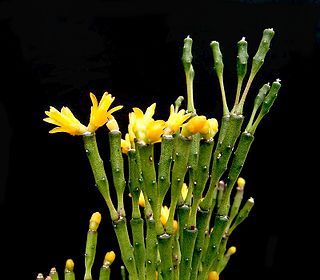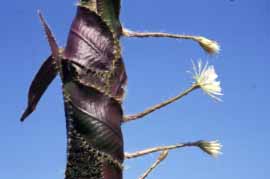
Schlumbergera is a small genus of cacti with six to nine species found in the coastal mountains of south-eastern Brazil. These plants grow on trees or rocks in habitats that are generally shady with high humidity, and can be quite different in appearance from their desert-dwelling cousins. Most species of Schlumbergera have stems which resemble leaf-like pads joined one to the other and flowers which appear from areoles at the joints and tips of the stems. Two species have cylindrical stems more similar to other cacti.

Disocactus is a genus of epiphytic cacti in the tribe Hylocereeae found in Central America, the Caribbean and northern South America. It should not be confused with Discocactus, which is a different genus.

Rhipsalis is a genus of epiphytic flowering plants in the cactus family, typically known as mistletoe cacti. They are found in parts of Central America, the Caribbean and northern regions of South America. They also inhabit isolated locations in Africa and Asia, and are the only cactus group naturally occurring in the Old World. This is the largest and most widely distributed genus of epiphytic cacti.

Hatiora is a small genus of epiphytic cacti which belongs to the tribe Rhipsalideae within the subfamily Cactoideae of the Cactaceae. Recent taxonomic studies have led to the three species formerly placed in subgenus Rhipsalidopsis being removed from the genus, including the well known and widely cultivated ornamental plants known as Easter cactus or Whitsun cactus.

Vatricania is a monotypic genus of flowering plants belonging to the family Cactaceae. It just contains one species, Vatricania guentheri(Kupper) Backeb.Greenm. ex Gleason It has the common name of Red Tail Cactus.

Rhipsalis baccifera, commonly known as the mistletoe cactus, is an epiphytic cactus which originates from Central and South America, the Caribbean, and Florida. It is also found throughout the tropics of Africa and into Sri Lanka where it is known in Sinhala as nawahandi (නවහන්දි). This is the only cactus species naturally occurring outside the Americas. One hypothesis is that it was introduced to the Old World by migratory birds, long enough ago for the Old World populations to be regarded as distinct subspecies. An alternative hypothesis holds that the species initially crossed the Atlantic Ocean on European ships trading between South America and Africa, after which birds may have spread it more widely.

Disocactus anguliger, commonly known as the fishbone cactus or zig zag cactus, is a cactus species native to Mexico. The species is commonly grown as an ornamental for its fragrant flowers in the fall.

Strophocactus brasiliensis, synonym Pseudoacanthocereus brasiliensis, is a species of plant in the family Cactaceae. It is endemic to Brazil. Its natural habitats are subtropical or tropical dry forests and hot deserts. It is threatened by habitat loss.

Rhipsalis pilocarpa, the hairy-fruited wickerware cactus, is a species of flowering plant in the cactus family that is endemic to Brazil. Scarce in the wild, it is known only in a small number of isolated locations. Its status is listed as “vulnerable” by the IUCN Red List. However, it is cultivated as an ornamental houseplant and as such has gained the Royal Horticultural Society’s Award of Garden Merit.
Schlumbergera kautskyi is a species of plant in the family Cactaceae. It is endemic to a small area of the coastal mountains of south-eastern Brazil where its natural habitat is rocky areas. It is threatened by habitat loss. It is in the same genus as the popular houseplant known as Christmas cactus or Thanksgiving cactus.

The Rhipsalideae are a small tribe of cacti, comprising four or five genera. They grow on trees (epiphytes) or on rocks (lithophytes), where they either hang down or form creeping or upright shrubs. Their flowers open in the day and remain open at night; they may be either radially symmetrical (regular) or bilaterally symmetrical (zygomorphic). The fruits are berry-like, fleshy with smallish seeds.

Rhipsalidopsis gaertneri, synonyms Schlumbergera gaertneri and Hatiora gaertneri, is a species of epiphytic cactus which belongs to the tribe Rhipsalideae within the subfamily Cactoideae of the Cactaceae. Together with the hybrid with R. rosea, Rhipsalidopsis × graeseri, it is known, in English speaking countries in the Northern Hemisphere, as Easter cactus or Whitsun cactus and is a widely cultivated ornamental plant. It has received the Royal Horticultural Society's Award of Garden Merit.

The Hylocereeae are a tribe of cacti. Most are found in the tropical forests of Central and northern South America, and are climbers or epiphytes, unlike most cacti. The tribe includes between six and eight genera in different circumscriptions. The plants known as "epiphyllum hybrids" or "epiphyllums", widely grown for their flowers, are hybrids of species within this tribe, particularly Disocactus, Pseudorhipsalis and Selenicereus, less often Epiphyllum, in spite of the common name.

Epiphyllum hybrids, epiphyllums, epicacti, or just epis, also known as orchid cacti, which are widely grown for their flowers, are artificial hybrids of species within the group of cacti placed in the tribe Hylocereeae. In spite of the common name, epiphyllum hybrids mainly involve Disocactus species instead of Epiphyllum species, though Selenicereus grandiflorus and some unconfirmed Epiphyllum species were reportedly used for hybridization. Other sources include Pseudorhipsalis in the parentage of the group.

Hatiora salicornioides, the bottle cactus, dancing-bones, drunkard's-dream, or spice cactus, is a species of flowering plant in the cactus family. A member of the tribe Rhipsalideae, it often grows as an epiphyte. It is native to eastern Brazil. It is sometimes grown both indoors and outdoors as an ornamental.

Rhipsalidopsis rosea, synonyms Hatiora rosea and Schlumbergera rosea, is a species of flowering plant in the family Cactaceae, native to south Brazil. It was first described, as Rhipsalis rosea, by Gustaf Lagerheim in 1912. It is one of the parents of the hybrid Rhipsalidopsis × graeseri, grown as the Easter or Whitsun cactus.
Schlumbergera lutea, synonym Hatiora epiphylloides, is a species of flowering plant in the family Cactaceae, subfamily Cactoideae, native to southeast Brazil. It is a shrubby epiphyte, with flattened stems and bright yellow flowers.

Hatiora cylindrica is a species of often epiphytic cactus in the tribe Rhipsalideae within the subfamily Cactoideae. It is native to east Brazil, where it grows in a variety of habitats, including moist forest, dunes and coastal rocks.

Strophocactus wittii, synonym Selenicereus wittii, known as the Amazon moonflower, is a species of plant in the genus Strophocactus in the cactus family (Cactaceae), and is one of several species commonly called "moonflowers". It was first described in 1900 and is one of three species of cactus found in the central Amazon basin.

Deamia testudo is a species of flowering plant in the family Cactaceae, native from southern Mexico through Central America to Nicaragua. It was first described in 1838. It is a climber or clamberer, with long stems and large white flowers.

















